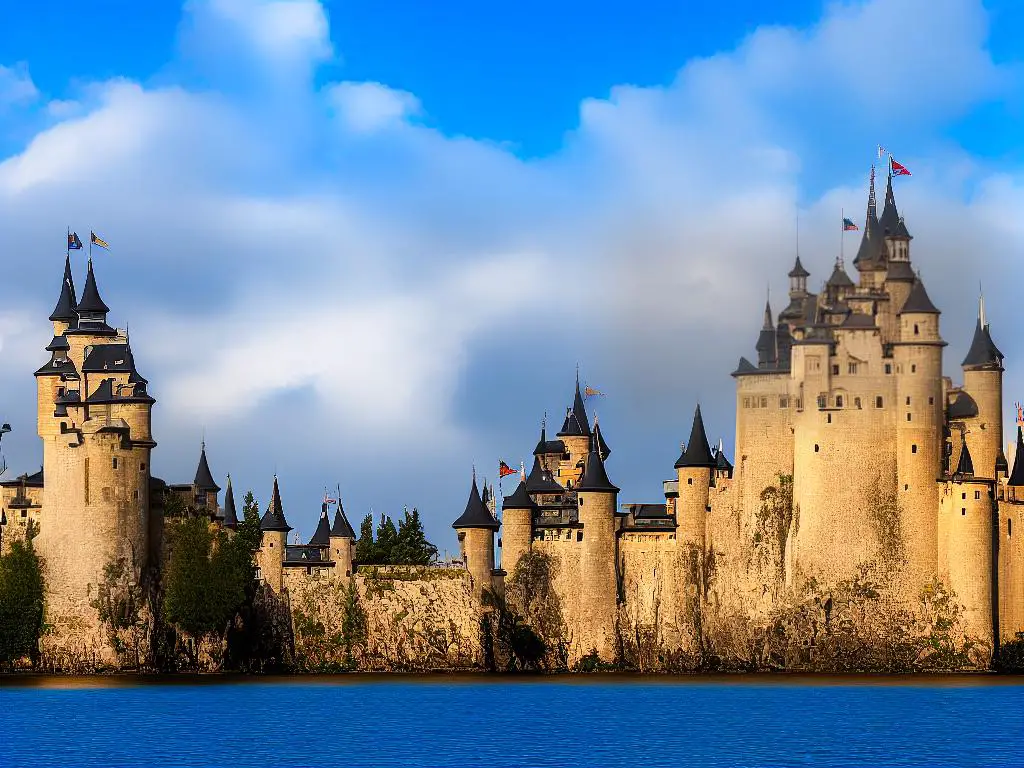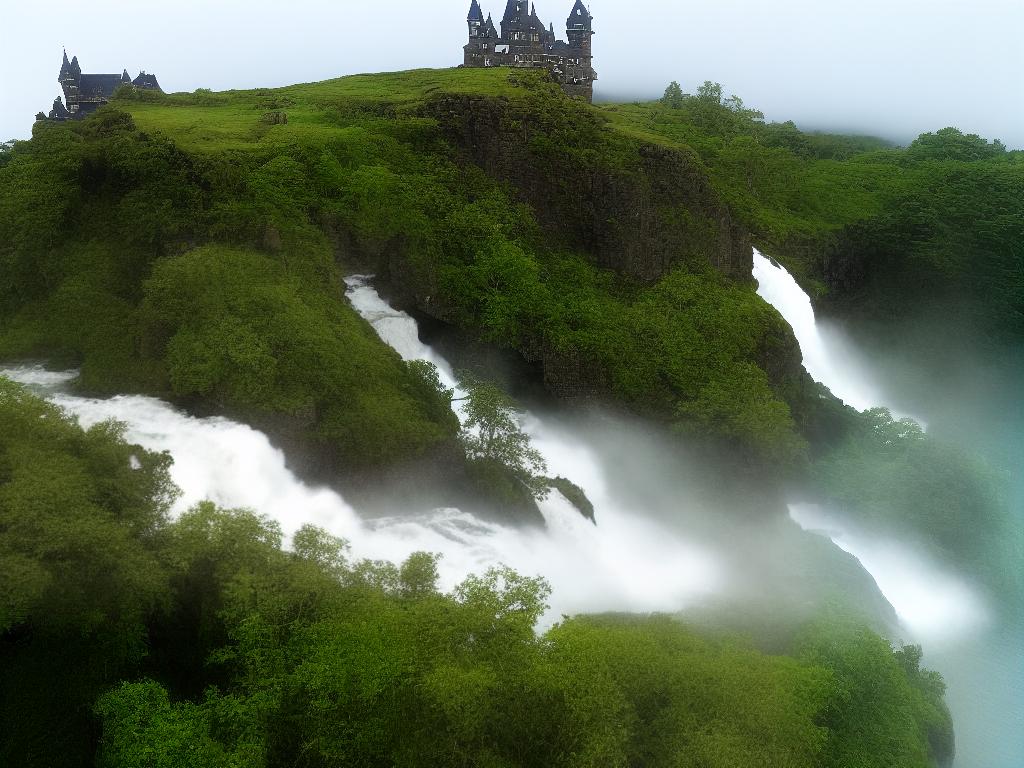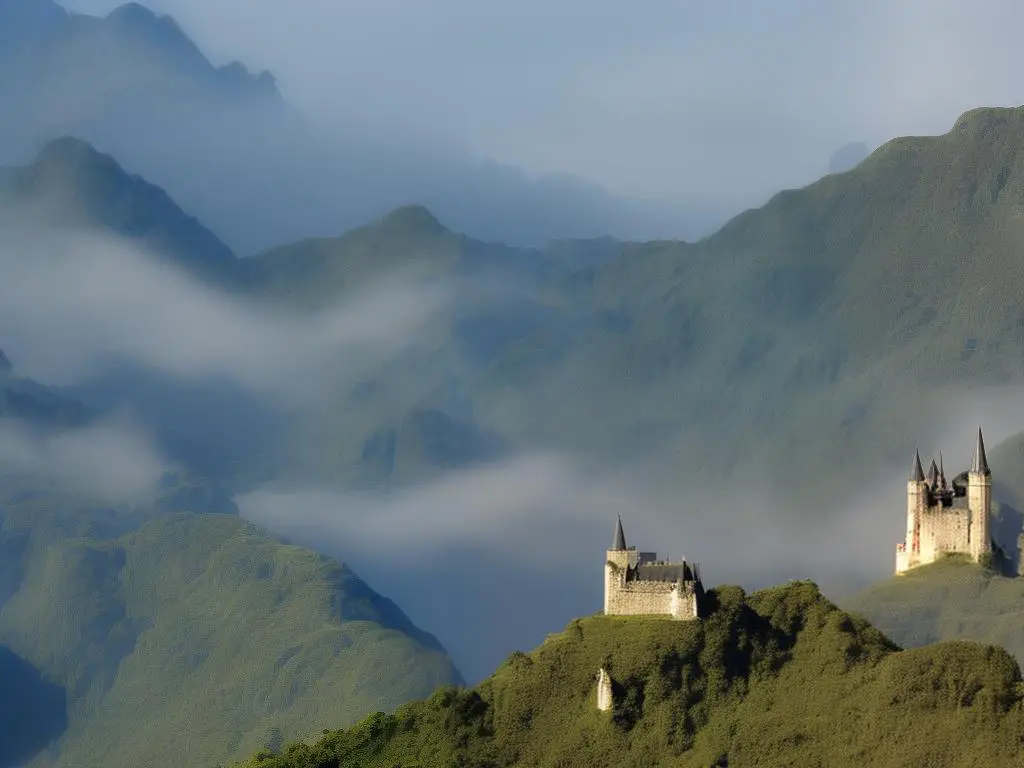Imagine a castle floating among the clouds, suspended by the power of dreams and fueled by the human imagination. The concept of the castle in the sky dream has captivated the minds of people for centuries and can be found woven into the fabric of various mythologies, literary works, and popular culture. This enchanting idea explores the deepest desires of humankind, whether it’s the quest for security, escapism, or a reflection of our unbridled ambition. In this essay, we will delve into the origins and inspiration behind the castle in the sky dream, discuss its symbolism and interpretations, examine its influence on art and architecture, explore its presence in popular culture, and ponder the scientific feasibility of manifesting this fantastical concept into reality.
Origins and Inspiration
Origins in Mythology
The concept of a castle in the sky dream can be traced back to various mythologies around the world. Floating castles or cities in the sky have been a common theme in countless stories and legends throughout human history. One of the earliest examples can be found in Hindu mythology, where the floating city of Shonitapura was ruled by the demon king Maya. This city was said to be made of iron and had the ability to disappear and reappear at will.
Another example from ancient Greek mythology is the ethereal Mount Olympus, the home of the twelve major gods and goddesses. This mountain was often depicted as floating in the sky, disconnected from the earth below. Similarly, Chinese mythology has various accounts of celestial palaces or heavenly realms, one of which is known as Jade Palace, the abode of the Jade Emperor.
Influences from Folklore
The idea of castles or cities in the sky is also prominent in various folktales and legends from around the world. In Middle Eastern folklore, it is said that the legendary city of Iram of the Pillars, also known as the Atlantis of the Sands, was once a magnificent city that floated high above the desert before being swallowed by the sands. Its location has long been a subject of mystery and intrigue, with multiple expeditions sent out to search for its remains.
In Japanese folklore, the floating city of Horai, also known as Mount Penglai, is a mystical land where immortals dwell. This island was believed to be located in the sea to the east of China and is often depicted as floating in the sky. It is said that those who reside in Horai can live forever without suffering from illness or old age.
Literary Inspirations
The idea of a floating castle or city in the sky has provided a captivating setting for numerous literary works, from classic fairy tales to modern-day fantasy novels. One of the most famous is the story of Jack and the Beanstalk, in which a young boy named Jack plants magic beans that grow into a gigantic beanstalk, leading him to a castle in the sky inhabited by a fearsome giant. This folktale has been told and retold in various forms across cultures for centuries.
In more modern literature, the floating city of Laputa appears as a setting in Jonathan Swift’s Gulliver’s Travels. In this story, Laputa is a flying island inhabited by scientists, engineers, and other intellectuals who use their knowledge to control the land below them. This concept has inspired other works such as Hayao Miyazaki’s film, Laputa: Castle in the Sky, which features a lost floating city filled with advanced technology and untold mysteries.
Another example is the popular video game series, BioShock, which includes the floating city of Columbia in its third installment, BioShock Infinite. This city is a utopian society formed in the clouds above the United States during the early 20th century. As players progress through the game, they unravel the dark secrets and conspiracies hidden beneath the city’s pristine surface.
Introduction to the Castle in the Sky Dream
The concept of a castle in the sky dream has been a part of human imagination for centuries. These floating cities and structures have roots in mythologies, folklore, and literary works from various cultures and historical eras. By capturing our sense of wonder and curiosity, they have provided the setting for countless stories that explore themes of adventure, knowledge, and the human quest for utopia or immortality.

Symbolism and Interpretation
Symbolism and Interpretation of the Castle in the Sky Dream
As a common dream motif, the castle in the sky represents various themes and symbols related to one’s life, such as desires for security, escape, or ambition. The image of a castle in the sky fundamentally symbolizes a lofty or seemingly unattainable goal or aspiration. The interpretation of this dream can vary depending on the dreamer’s background, preferences, or current life circumstances, often connecting with the themes found in the mythologies, folklore, and literature that have long fascinated us with the idea of floating cities and structures.
Security and Protection
In many cultures, castles are considered symbols of protection, strength, and security, as they historically served to defend cities and communities against external threats. As such, dreams of a castle in the sky might be interpreted as representing the dreamer’s desire for greater security and stability, either personally or professionally. This could encompass anything from a longing for financial security to the need for a more stable romantic relationship.
Escape and Transcendence
Another interpretation of the castle in the sky dream involves the idea of escape, which can take many forms. For some, the castle represents a world of fantasy and escape from the mundane realities of everyday life. In this context, the dream may indicate a desire to retreat to a more idyllic, fanciful place or situation, where one can feel temporarily removed from the burdens and pressures of reality.
For others, a castle in the sky can symbolize a more spiritual or transcendent form of escape, possibly conveying a longing to connect with higher realms of consciousness or gain a broader perspective on life. In such cases, the dream may serve as a reminder for the dreamer to cultivate a deeper sense of spiritual connection or seek out new insights and ways of thinking about their place in the world.
Ambition and Aspiration
As a towering, grandiose structure, a castle is often associated with wealth, power, and status. Within the context of the castle in the sky dream, such a symbol might point toward the dreamer’s ambitions and aspirations, especially if they feel that their personal or professional goals are out of reach. The dream may serve to remind the dreamer that they continue to strive for greater heights and that they are committed to pursuing their goals despite any obstacles or setbacks they may encounter.
Psychoanalytical and Cultural Perspectives
From a psychoanalytical standpoint, the castle in the sky dream might be interpreted as reflecting unresolved or repressed feelings, desires, or fears. For instance, the dreamer may be struggling with feelings of inadequacy or insecurity, leading them to seek solace in the dream world through grandiose fantasies of castles and lofty aspirations.
In some Western cultural contexts, dreams of castles in the sky might be connected with ideals of romantic love, chivalry, or fairy-tale-like fantasies of true love ‘conquering all.’ In such a case, the dreamer may be exploring their fantasies of an ideal romantic partner or relationship, or perhaps experiencing nostalgia for a time when they believed more wholeheartedly in the possibility of such a love story.
Exploring the Castle in the Sky Dream
The concept of a “castle in the sky” has played an important role in human imagination and dreams throughout history. Stemming from ancient mythologies and religious beliefs, various cultures have envisioned awe-inspiring cities, sprawling palaces, or heavenly abodes floating above the Earth. It’s essential to interpret the symbolism of a castle in the sky dream from the dreamer’s unique perspective to better understand its meaning and potential significance in one’s life. Dreams embodying this theme can reveal hidden desires, aspirations, and unfulfilled needs, offering a window for introspection and personal growth.

Architectural and Artistic Depictions
Architectural Influence of Castle in the Sky Dreams
Transcending dreams, the castle in the sky idea has inspired architects, artists, and designers throughout history. From ancient civilizations, such as the wonderous Hanging Gardens of Babylon, to the Gothic cathedrals of the Medieval period, humankind has continually attempted to bring this fantasy to life. The Hanging Gardens represented a green oasis that seemed to hover mid-air, showcasing the perfect blend of nature and human ingenuity to create a floating sanctuary.
Modern architecture continues to incorporate and pay homage to the castle in the sky dream. Santiago Calatrava’s twisting skyscraper, the Turning Torso in Malmö, Sweden, exemplifies this concept. This gravity-defying tower combines residential, commercial, and recreational spaces in a spiraling structure that appears to defy the laws of physics. Blurring the lines between reality and fantasy, the Turning Torso illustrates the enduring influence and importance of the castle in the sky dream in both our subconscious and built environments.
Artistic Depictions of the Castle in the Sky Dream
Similarly, the castle in the sky dream has captivated the minds of countless artists throughout history, often manifesting in fantastical artwork depicting otherworldly cities suspended in the clouds. Such themes can be found in paintings such as Giorgio de Chirico’s “The Uncertainty of the Poet” and Salvador Dalí’s “The Temptation of St. Anthony,” where floating architectural structures challenge the viewer’s perception of reality.
Japanese animation director Hayao Miyazaki brought the castle in the sky dream to life in his critically acclaimed film “Laputa: Castle in the Sky.” The titular castle is a mythical and ancient city that floats high above the clouds. Its intricate design and advanced technology serve as a testament to human ingenuity and creativity. This dreamlike mise-en-scène continues to capture the hearts and minds of viewers, inspiring a new generation of artists and storytellers.
Challenges and Creativity in Design
Architects and designers have always been inspired by the castle in the sky dream, a fantastical concept that challenges the limits of imagination and technology. Today, with advancements in engineering and construction capabilities, they have more opportunities than ever before to turn these dreams into a reality. However, the task of balancing the grandeur of these sky-high fantasies with practical constraints such as budgets, environmental concerns, and modern construction techniques is no small feat.
Achieving a perfect blend of the fantastical and the functional requires both ingenuity and precision. Designers not only have to overcome the technical challenges of achieving such lofty ideas but also must consider the psychological and emotional aspects of their designs. In doing so, they create structures and environments that not only defy convention but also deeply resonate with our collective human spirit.
The castle in the sky dream continues to serve as a rich source of inspiration for architects, artists, and designers throughout history and into the present day. From ancient hanging gardens to modern skyscrapers, this remarkable concept challenges creative professionals to push their craft to new heights. With their unwavering dedication to imagination and innovation, they continue to produce awe-inspiring structures and artwork that transport us to a world of ethereal beauty and wonder.

Popular Culture References
Popular Culture’s Take on Castles in the Sky
The castle in the sky dream also pervades popular culture, making appearances in various forms, such as films, literature, and video games. These depictions often portray idyllic places above the clouds where whimsical and fantastic events take place, captivating audiences with themes of adventure, imagination, and the blur between dream and reality. Let’s delve into these portrayals to better understand how they resonate with audiences and tie into the broader aspirations of architects and designers who bring such visions to life.
Laputa: Castle in the Sky
One of the most iconic films featuring a castle in the sky is the 1986 Japanese animation film “Laputa: Castle in the Sky” by Hayao Miyazaki and Studio Ghibli. The film combines well-loved themes of adventure, discovery, and the fate of humanity through the exploration of a mythical floating island named Laputa. This castle in the sky acts as a symbol of progress and human ambition, as well as a warning about the dangers of unchecked technology and power. The film resonates with audiences because of its breathtaking visuals and endearing characters, such as Pazu and Sheeta, who must find their place in a world where dreams and reality collide.
Gulliver’s Travels
In literature, “Gulliver’s Travels” by Jonathan Swift includes a section called “The Floating Island of Laputa.” This floating castle serves as a commentary on the absurdity of human nature and a critique of political and scientific systems. Through the experiences of Gulliver, Swift humorously portrays the residents of Laputa as radically detached from reality, so invested in their own intellectual pursuits that they cannot see the world around them. This literary portrayal resonates with readers as it uses the castle in the sky as both an otherworldly realm and a metaphor for human society.
Symbolism in Video Games
The symbolism of castles in the sky extends to video games as well. Games such as “Bioshock Infinite” and “Skyward Sword” feature mysterious cities floating in the sky that are ripe for exploration and imbued with myth and legend. In “Bioshock Infinite,” the city of Columbia serves as a backdrop for a gripping narrative that exposes the darkness beneath its outwardly pristine and idealistic appearance. In “The Legend of Zelda: Skyward Sword,” the floating city of Skyloft symbolizes a haven above the chaos of the world below, providing protagonists Link and Zelda with a place to call home as they embark on their perilous quest to save the world.
Enduring Appeal
The theme of castles in the sky holds enduring appeal for audiences because it represents an escape from the mundane and an opportunity to explore the uncharted realms of imagination. They serve as symbols of human ambition, as portals to other worlds, and as the backdrop for tales of heroism, romance, and adventure.
Exploring the Dreamlike Wonders of Castles in the Sky
The concept of castles in the sky holds a perennial fascination, representing both our hopes and aspirations in fantastical forms. These ethereal constructs often inspire awe and amazement, as well as contemplation on the nature of reality, the dreams that resonate with us, and the desires of those who envision them. Further, in considering the possibility of transforming these marvelous flights of fancy into reality, one may delve into a world of advanced materials, engineering techniques, and space technology.

Scientific Feasibility and Future Possibilities
Unlocking the Potential of Advancements in Materials and Engineering
To bring a castle in the sky or a floating city into existence, we must venture into the realm of cutting-edge engineering and materials science. At present, developments in lightweight materials, such as carbon fiber composites, offer promising solutions due to their high strength-to-weight ratio. Such materials, employed in aerospace applications, may eventually serve as the foundation for constructing large structures capable of withstanding the conditions of a skyward environment.
Another technique that may pave the way for sky castles is tensegrity, a structural system comprising compressed elements within a network of tensioned components. Featuring exceptional strength, stability, and lightweight properties, tensegrity structures are well-suited to architectural applications such as bridges and long-span structures.
Interestingly, current projects in space engineering and technology exhibit concepts akin to floating castles. One example is the International Space Station (ISS), which orbits Earth at an altitude of approximately 420 kilometers. The ISS demonstrates the potential of maintaining substantial structures in a near-weightless environment, owing to its delicate balance of gravity and orbital velocity. While not a true castle in the sky, the ISS represents a vital step toward making such dreams a reality.
Lifting Technology and Propulsion Systems
For a castle in the sky to become a reality, it would require a reliable method of propulsion and lifting technology for it to remain airborne. Currently, airships or aerostats that use lighter-than-air gases like helium or hydrogen to achieve buoyancy are the most feasible option for lifting heavy loads into the sky. In recent years, there have been advancements in the development of hybrid airships, which combine the buoyancy with thrust from propellers, allowing for efficient and stable flight.
One promising development in lifting technologies is the concept of space elevators, which involves attaching a tether from the Earth’s surface to a counterweight in space that would pull the structure upward. While this technology is still in its infancy and faces numerous engineering challenges, it could provide a feasible solution for maintaining a floating castle in the future.
Potential Benefits of Living in a Sky Castle
- The possibility of reducing overcrowding on the ground.
- Alleviating the need for land-based resources.
- More efficient harnessing of solar power thanks to altitude and exposure to sunlight.
- Potential scientific research outposts or space tourism destinations.
- New economic opportunities.
- Reducing environmental pressures on the ground.
- Providing a means for waste disposal and recycling that minimizes pollution.
Challenges and Considerations for Sky Castles
- Safety and security of these structures, especially against extreme weather events such as hurricanes or tornadoes.
- Cost of constructing and maintaining a floating city.
- Access to essential resources for residents such as water, food and air.
- Social and psychological aspects of living in a floating city (isolation from terrestrial communities, mental health of residents, social cohesion).
Conclusion
While the concept of a castle in the sky or a floating city is still largely a dream, current advancements in engineering, materials science, and space technology are providing critical steps towards making this dream a reality. The potential benefits of these floating communities cannot be ignored, but they come with their own set of challenges that must be addressed to ensure a safe and sustainable environment for those who choose to call the sky their home.

As we journey through the ethereal world of the castle in the sky dream, it becomes evident that this powerful concept is more than just a flight of fancy. Its rich history, profound symbolism, and lasting impact on art, architecture, and popular culture serve as testaments to its enduring allure. As our world continues to advance, the merging of science and imagination may one day turn these floating fortresses from a whimsical dream into an astonishing reality. In the meantime, the castle in the sky will continue to fuel our collective imagination, reminding us to dream big and never stop reaching for the stars.
